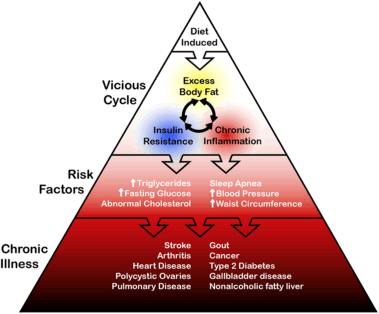|
|
|
|
|
|
|
Newsletter 1 – September 20, 2017
What does overfat mean? How can we tell if we are overfat?
Changes in lifestyle have led to 70 to 90% of us having too much fat, we
are "overfat". This means that even if we may have a normal body
mass index, or our hip to waist ratio is within "normal limits" or the
scale tells us we are at our high school weight, we may still be overfat.
The journal article available at the link below discusses a large
segment of the developed world:
http://journal.frontiersin.org/article/10.3389/fpubh.2017.00190/full#h7
So, what happens if we are overfat?
Essentially this condition sets us up for increased risk of a whole host
of problems as shown below by this diagram from the article.
How can we tell if we are overfat? If 2 times your waist measurement is greater
than your height, you are overfat.
Citation for both diagrams: Front. Public Health, 24 July 2017 | https://doi.org/10.3389/fpubh.2017.00190
That's right, it's an ongoing
maintenance project for all us. It never stops. Being healthy is
all about moderation and lifestyle, and focusing on The Big
Four.
The
Big Four, listed below, strengthen your immune system. And if your
immune system is healthy, you are tipping the scale, so to speak,
towards aging gracefully rather than decaying as you age. You will
be more resistant to cancer, cardiovascular disease, and inflammatory
illness.
Getting healthy is more than 80% about what you eat. The core
therapy for cholesterol management and for many other issues such as
blood sugar, blood pressure, gout, sleep apnea and pain associated with
osteoarthritis, is attaining a weight that is healthy for you.
Often, a small reduction in weight (just 10-15 pounds) will translate
into a remarkable improvement in health. A reduction in weight of
just one-pound unloads 4 pounds/square inch on your weight-bearing
joints, including the lower back.
Attaining and maintaining a healthy weight is a
constant process of making adjustments. It is a challenging
process. Perhaps the biggest obstacle is that your brain's pleasure
center is constantly demanding you to seek and eat calorie-dense foods.
This mechanism evolved for prehistoric humans in order to avoid famine.
Today, food is abundant and food technology has created unhealthy but
alluring foods full of white flour, sugar, salt and bad fat - everything
the pleasure center craves. And the more we eat these easily stored
dense caloric foods, the more we strengthen the pleasure center's hold
on us. However, we can reset the pleasure center. It takes hard work and
discipline but in days to weeks, we can tame the beast. Lifestyle
changes can modify the neurological networks and inhibit our cravings
for unhealthy foods.
Here are a few tips to healthy eating:
Want to learn more? Want to do something about being overfat, or
if you're not overfat, just want to get yourself in better shape?
Consider joining BOOM -- which stands for Boost
Our Own Metabolism -- a program that I
developed, and for 3 years running, teaches key nutritional points and
provides tips for improving sleep and stress levels. The next
session of BOOM begins on Wednesday, October 4 and runs through December
20, from 7:15 - 8:00 am in the cycling studio at the Columbia Athletic
Club. We spin on the studio bikes to music using a High-Intensity
Interval Training (HIIT) format. My assistant, Stacey, will once again
be leading the spin portion and this is preceded by my brief talk on the
topic of the week. If you're unsure whether or not you are healthy
enough to participate, please send me an email and I can let you know if
BOOM is right for you.
Here is a video about BOOM https://youtu.be/kbnhzxjN3YE if you have any
questions (please note that the details regarding days and dates in the
video do not pertain
to this upcoming session).
Here are registration instructions:
Columbia Association members: there is no charge. Sign up online
through the CA website or app beginning at 2:00 pm on Mondays or call
the Athletic Club beginning 2:00 pm on Tuesdays.
·
October - 4 classes/$40
total
·
November - 5 classes/$50
total
·
December - 3 classes/$30
total
Registration and payment can be made in person at the front desk of the
Athletic Club or by calling there (410-730-6744). Please note that
payment must be made for an entire month, there is no pro-rating or
partial refunds.
Stay tuned for my next Newsletter update in a few weeks, and I will give
you more sound advice on vitamins and supplements.
Remember: put your health first!
Wishing you good health,
HAO
Clinical Professor of
Medicine
University of Maryland School of Medicine Office: 410-910-7500 Fax: 410-910-2310 Cell: 443-324-0823 |



